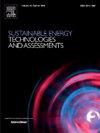Numerical investigation of the position effect on a hybrid wind turbine model: Integrating vertical axis wind turbines around a horizontal axis wind turbine tower
IF 7.1
2区 工程技术
Q1 ENERGY & FUELS
Sustainable Energy Technologies and Assessments
Pub Date : 2025-04-01
DOI:10.1016/j.seta.2025.104304
引用次数: 0
Abstract
A numerical investigation is conducted on a novel hybrid wind turbine model, integrating VAWTs around a HAWT tower to enhance the overall power of HAWT. The performance of a single VAWT placed around an offshore HAWT tower is evaluated, at various position (0°,45°,60°,90°) to determine the optimal position of VAWT for maximizing power output. The study maintains a constant gap of 5.4 m from the center of tower to the middle of turbine, with constant wind velocity of 8 m/s. A three-dimensional simulation is performed to assess the aerodynamic effect of accelerated flow and high velocity created by the tower on VAWTs power performance, and compared these results to those obtained without the HAWT tower. The results indicate that the tower structure creates regions of high wind speed and stagnation regions. VAWT power output is enhanced in the high-speed regions, while power output decreases in front of the tower due to stagnation effects. At 0°, the power coefficient is at a minimum of 0.0837, lower than that of turbines without the tower. At 60° and 90°, the coefficients improve to 0.4864 and 0.5487, respectively. Additionally, integrating small turbines on both sides at the 90° position increases HAWT power by 0.83 %.
位置效应对混合风力机模型的数值研究:垂直轴风力机围绕水平轴风力机塔集成
对一种新型的混合风力机模型进行了数值研究,该模型将多轴多轴风力机集成在HAWT塔周围,以提高HAWT的整体功率。在不同位置(0°,45°,60°,90°),评估放置在海上HAWT塔周围的单个VAWT的性能,以确定VAWT的最佳位置,以最大限度地提高功率输出。本研究保持塔身中心到涡轮机中部5.4 m的恒定间隙,风速恒定为8 m/s。通过三维仿真,评估了塔架加速流动和高速对发动机动力性能的影响,并与未安装塔架时的结果进行了比较。结果表明,塔式结构产生了高风速区和滞止区。在高速区域VAWT功率输出增强,而在塔前由于滞流效应功率输出降低。在0°时,功率系数最小为0.0837,低于无塔时的功率系数。在60°和90°时,系数分别提高到0.4864和0.5487。此外,在两侧90°位置集成小型涡轮机可增加0.83%的HAWT功率。
本文章由计算机程序翻译,如有差异,请以英文原文为准。
求助全文
约1分钟内获得全文
求助全文
来源期刊

Sustainable Energy Technologies and Assessments
Energy-Renewable Energy, Sustainability and the Environment
CiteScore
12.70
自引率
12.50%
发文量
1091
期刊介绍:
Encouraging a transition to a sustainable energy future is imperative for our world. Technologies that enable this shift in various sectors like transportation, heating, and power systems are of utmost importance. Sustainable Energy Technologies and Assessments welcomes papers focusing on a range of aspects and levels of technological advancements in energy generation and utilization. The aim is to reduce the negative environmental impact associated with energy production and consumption, spanning from laboratory experiments to real-world applications in the commercial sector.
 求助内容:
求助内容: 应助结果提醒方式:
应助结果提醒方式:


